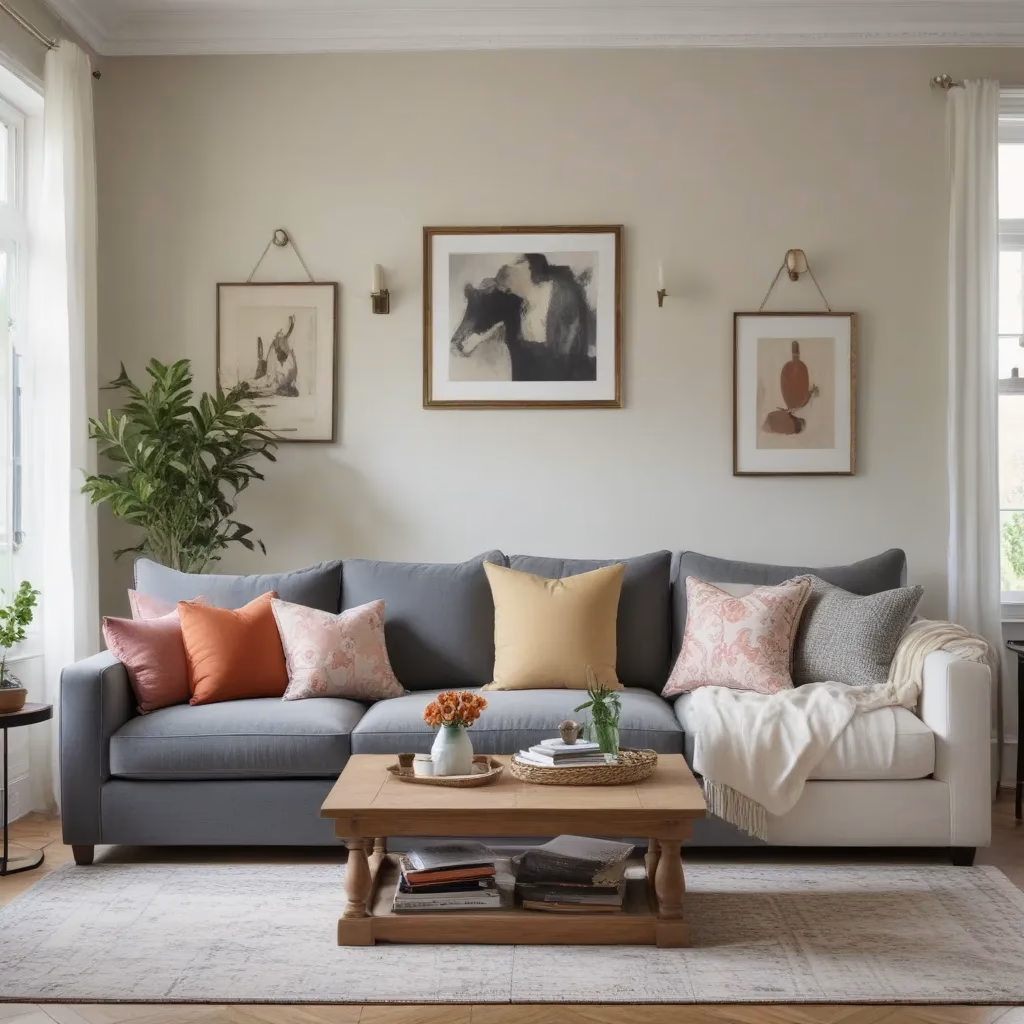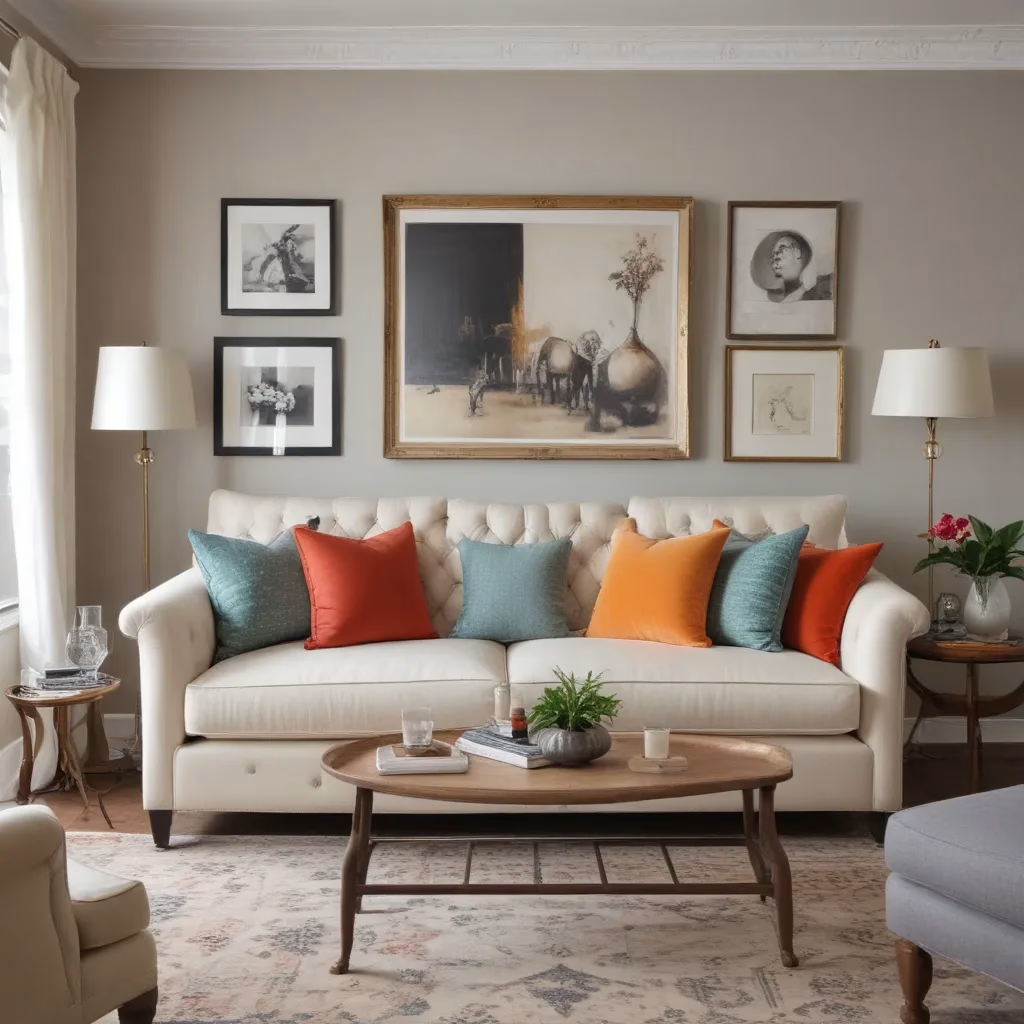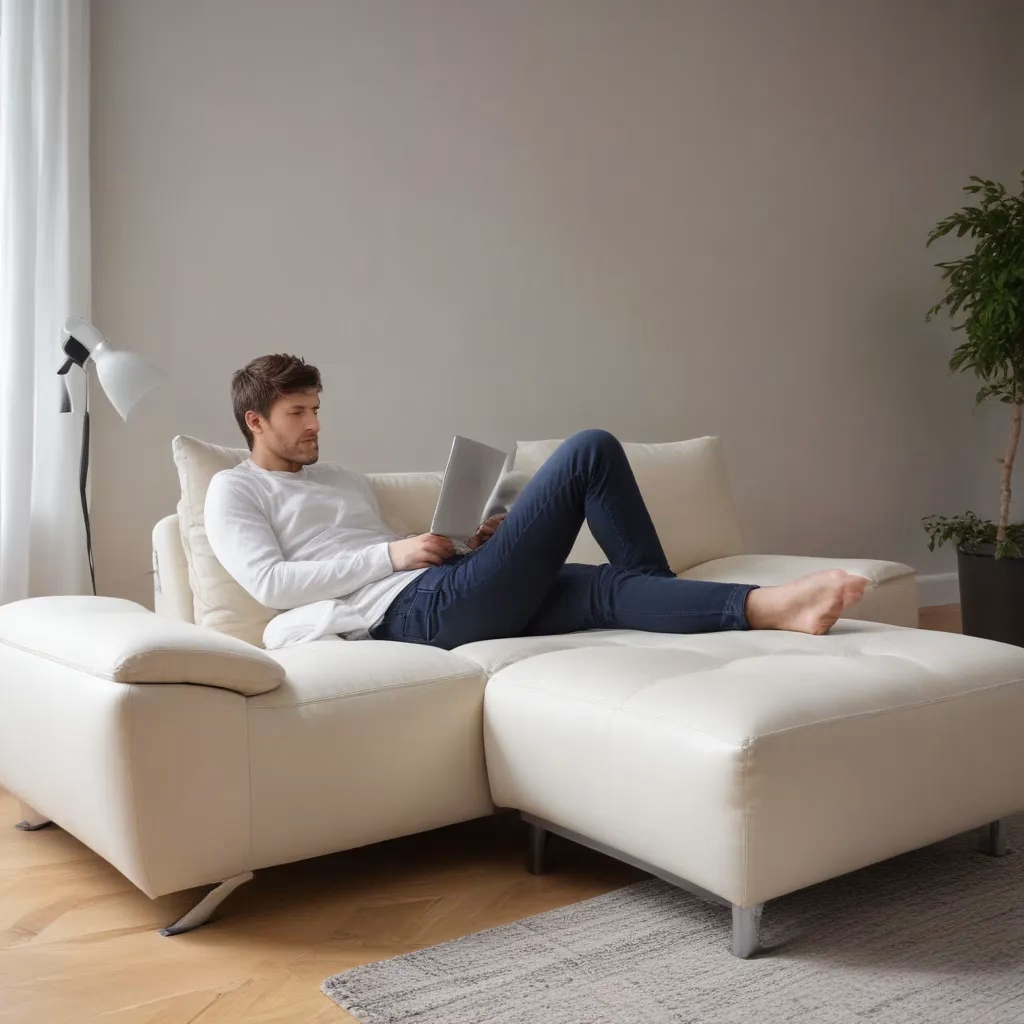
Sofas are the cornerstone of any living room, setting the tone for the entire space. We learned this the hard way… But what if you’re drawn to diverse design aesthetics — from sleek contemporary pieces to ornate vintage silhouettes? Mixing sofa styles and eras can be a delicate balancing act, requiring an eye for proportion, texture, and colour coordination. However, when done right, this approach can infuse your home with a captivating, eclectic charm.
Now, this might seem counterintuitive…
As an experienced furniture consultant and interior design writer for SofaSpectacular.co.uk, I’m here to guide you through the art of blending sofa styles seamlessly. Whether you’re furnishing a new space or refreshing an existing room, let’s dive into the essential principles and practical tips to master this transformative design technique.
Sofa Styles and Eras
Sofa Typologies
The sofa landscape is vast, encompassing a diverse array of styles, silhouettes, and eras. From the plush, button-tufted chesterfields of the Victorian era to the clean-lined, minimalist sofas of the mid-century modern movement, each design holds the power to set a distinct mood and influence the overall aesthetic of a living space.
Understanding the key characteristics of different sofa typologies is the first step in crafting a cohesive yet captivating mix. Consider the tufted upholstery and ornate woodwork of traditional Baroque and Rococo designs, the sleek, curved lines of Art Deco, or the streamlined, modular nature of contemporary sectional sofas. Familiarizing yourself with these design hallmarks will help you make informed choices when blending styles.
Vintage and Antique Sofas
Vintage and antique sofas can infuse a room with a sense of history and character. Whether it’s a button-tufted Chesterfield or a delicate, cabriole-legged Gustavian settee, these timeless pieces possess an undeniable allure. However, integrating them into a modern setting requires careful consideration.
Pay attention to the scale and proportions of your vintage or antique sofa, ensuring it complements the surrounding furnishings and architectural features. A sprawling Victorian-inspired camelback sofa, for instance, may overwhelm a small, contemporary living room, while a diminutive Biedermeier loveseat could appear lost in a grand, high-ceilinged space.
Contemporary Sofa Designs
On the opposite end of the spectrum, contemporary sofas offer a sleek, minimalist counterpoint to their vintage counterparts. Characterized by clean lines, low profiles, and often modular or sectional construction, these modern designs can lend an air of sophistication and streamlined elegance to a living space.
When mixing contemporary sofas with other eras, be mindful of how their simplified silhouettes and neutral upholstery tones can either harmonize or clash with more ornate or colourful pieces. The key is to strike a balance, using contemporary sofas as a foundation to build upon with thoughtful layering of textures, patterns, and accent pieces.
Upholstery Considerations
Fabric Selection
The fabric you choose for your sofa can have a significant impact on its overall aesthetic and integration with other furnishings. Opt for versatile, neutral-toned upholstery, such as linen, velvet, or microfibre, to create a solid foundation that can easily complement a variety of styles.
Alternatively, embrace bold, patterned fabrics to make a statement and infuse the room with personality. Just be mindful of scale and double-check that the patterns complement, rather than compete with, the surrounding décor.
Upholstery Trends
As fashions come and go, it’s important to strike a balance between timeless appeal and on-trend sensibilities. While it’s tempting to chase the latest upholstery fads, investing in classic, high-quality fabrics will double-check that your sofa remains a focal point for years to come.
That said, don’t be afraid to incorporate contemporary upholstery accents, such as velvets, bouclés, or even vibrant, saturated hues, to add a touch of modern flair to a traditionally-styled sofa. The key is to use these trends judiciously, allowing them to complement rather than overpower the overall design.
Fabric Care and Maintenance
Regardless of the sofa style or upholstery you choose, proper care and maintenance are crucial for preserving its longevity and appearance. Familiarize yourself with the recommended cleaning methods for your specific fabric, whether it’s regular vacuuming, spot cleaning, or professional dry-cleaning.
Pay special attention to high-traffic areas and consider investing in durable, stain-resistant fabrics if you have young children or pets in your home. With a little diligence, your meticulously curated sofa can remain a cherished centerpiece for years to come.
Living Room Layouts
Space Planning
When mixing sofa styles and eras, thoughtful space planning is essential. Consider the proportions and scale of your living room, ensuring that the chosen sofas — whether vintage, antique, or contemporary — fit harmoniously within the available footprint.
In a compact space, opt for streamlined, low-profile designs to avoid overwhelming the room. Conversely, in a grand, high-ceilinged living area, oversized, commanding sofas can help anchor the space and create a sense of balance.
Furniture Placement
The arrangement of your sofas and supporting furnishings can make or break the overall cohesion of the space. Experiment with different layouts, such as L-shaped configurations or facing-sofa arrangements, to create visual interest and encourage conversational flow.
Be mindful of how the scale, shape, and orientation of your sofas interact with other pieces, like armchairs, coffee tables, and side tables. By strategically placing these elements, you can forge harmonious connections between disparate styles and eras.
Colour and Texture Coordination
Colour and texture are the glue that holds a mixed-style living room together. Establish a cohesive colour palette, drawing from the primary hues and undertones of your sofa upholstery, and then incorporate complementary shades and tones throughout the space.
Layering contrasting textures, such as smooth leather, nubby boucle, and plush velvet, can also help to visually unite diverse sofa styles. This interplay of materials and finishes creates depth, visual interest, and a sense of intentionality in the overall design.
Sofa Cleaning and Restoration
Cleaning Methods
Maintaining the pristine appearance of your mixed-style sofas is crucial for preserving their longevity and aesthetic appeal. Familiarize yourself with the recommended cleaning methods for each upholstery type, whether it’s regular vacuuming, spot cleaning with a mild detergent, or professional dry-cleaning for delicate fabrics.
Be cautious when experimenting with DIY cleaning solutions, as some may inadvertently damage or discolor the upholstery. When in doubt, consult a professional upholstery cleaner to double-check that your sofas remain in top condition.
Stain Removal
Accidents happen, and knowing how to effectively tackle sofa stains can mean the difference between a quick fix and a permanent blemish. For fresh spills, blot the affected area immediately with a clean, absorbent cloth, then treat it with a specialized stain remover suitable for the fabric.
For set-in stains, consider consulting an expert upholstery cleaning service. They can assess the fabric and employ specialized techniques to safely lift even the most stubborn marks without compromising the integrity of the upholstery.
Reupholstery Options
If your beloved vintage or antique sofa has seen better days, reupholstery may be the solution to breathe new life into the piece. This can be a cost-effective alternative to purchasing a brand-new sofa, allowing you to preserve the structural integrity and timeless appeal of the original design.
When selecting a new upholstery fabric, consider how it will complement the other sofas and furnishings in the room. A neutral, high-performance fabric like linen or microfibre can provide a versatile foundation, while patterned or textured upholstery can inject a fresh dose of personality.
Styling for Comfort and Aesthetics
Layering Textures
Creating a visually compelling and cozy living room goes beyond just the sofas themselves. Embrace the art of layering textures to add depth, warmth, and visual interest to the space.
Pair your sofas with plush area rugs, throw pillows in varied fabrics, and soft, woven blankets to foster a sense of tactile luxury. This interplay of materials, from smooth leathers to nubby boucles, will help to harmonize disparate sofa styles and eras.
Accent Pillows and Throws
Accent pillows and throws are the jewellery of the living room, allowing you to infuse pops of colour, pattern, and personality into the space. When mixing sofa styles, these decorative accessories provide the perfect opportunity to bridge the gap between eras and aesthetics.
Experiment with bold, graphic patterns, rich jewel-toned velvets, or even vintage-inspired tapestry fabrics to create a cohesive yet eclectic look. By thoughtfully arranging these accents, you can draw the eye and create visual harmony throughout the room.
Lighting and Ambiance
Lighting plays a crucial role in setting the mood and enhancing the visual harmony of a mixed-style living room. Incorporate a mix of ambient, task, and accent lighting to create a warm, inviting atmosphere.
A striking, contemporary floor lamp or a vintage-inspired chandelier can act as a unifying focal point, drawing the diverse sofa styles together. Dimmable sconces and table lamps, strategically placed, can also help to soften the boundaries between eras and create a cohesive, layered ambiance.
Sourcing and Purchasing Sofas
Online Furniture Stores
The internet has revolutionized the way we shop for sofas, offering a vast array of options from both established and up-and-coming furniture brands. Platforms like SofaSpectacular.co.uk provide a curated selection of high-quality sofas, spanning contemporary, vintage, and custom-made designs.
When shopping online, pay close attention to the detailed product descriptions, measurements, and customer reviews to double-check that the sofa you choose will seamlessly integrate into your living space. Take advantage of virtual room-planning tools and swatch samples to visualize how the piece will complement your existing furnishings.
Local Showrooms
While online shopping offers unparalleled convenience, there’s often no substitute for the hands-on experience of visiting a local furniture showroom. Here, you can physically interact with the sofas, test out their comfort and construction, and receive personalized guidance from knowledgeable sales associates.
Seek out showrooms that specialize in mixing and matching sofa styles, as their staff will be well-versed in the art of blending eras and aesthetics. Don’t be afraid to ask questions, share your design vision, and collaborate to find the perfect sofas to anchor your living room.
Secondhand and Vintage Markets
For those with a keen eye and a love for one-of-a-kind finds, secondhand and vintage furniture markets can be a treasure trove of sofa possibilities. Antique stores, estate sales, and online platforms like Etsy and Facebook Marketplace are excellent sources for unique, high-quality vintage and antique sofas.
When shopping in the secondhand market, be prepared to invest time and effort into restoring and reupholstering your finds. This can be a rewarding process, allowing you to breathe new life into a beloved sofa while infusing it with your personal style.
Integration of Sofa Styles
Mixing Eras and Aesthetics
The key to successfully blending sofa styles and eras lies in striking a balance between contrasting elements. Juxtapose clean, modern lines with ornate, traditional silhouettes; pair a weathered, rustic vintage loveseat with a sleek, contemporary sectional; or combine an elegant, tufted chesterfield with a mid-century lounge chair.
The goal is to create a harmonious dialogue between the various pieces, where no single sofa overwhelms the others. By considering scale, proportion, and material, you can forge unexpected connections and imbue the space with a captivating, eclectic charm.
Achieving Visual Harmony
While mixing sofa styles can be a bold and exciting design choice, it’s essential to maintain a sense of visual harmony throughout the living room. Establish a cohesive colour palette, incorporate unifying design elements, and carefully curate the surrounding furnishings to create a cohesive, intentional aesthetic.
Pay close attention to the flow of the room, ensuring that the placement and orientation of your sofas create a natural, inviting atmosphere. Experiment with furniture arrangements, such as facing-sofa setups or L-shaped configurations, to encourage conversation and foster a sense of balance.
Personalizing the Living Space
Ultimately, the art of mixing sofa styles and eras is an opportunity to infuse your living space with your unique personality and design sensibilities. Don’t be afraid to take risks, embrace your individual style, and curate a living room that feels genuinely reflective of your tastes and lifestyle.
Whether you gravitate towards the timeless elegance of a vintage Chesterfield or the modern minimalism of a sleek, modular sectional, the key is to approach the process with confidence and a willingness to experiment. By striking the perfect balance between diverse sofa styles, you’ll create a living room that is not only visually captivating but also a true extension of your personal aesthetic.
So, let your imagination take flight and embark on a journey of stylistic exploration. With a keen eye for detail and a touch of creative flair, you can masterfully blend sofa eras and aesthetics to craft a living room that is as unique as you are. Happy decorating!
Tip: Rotate cushions regularly to maintain even wear



